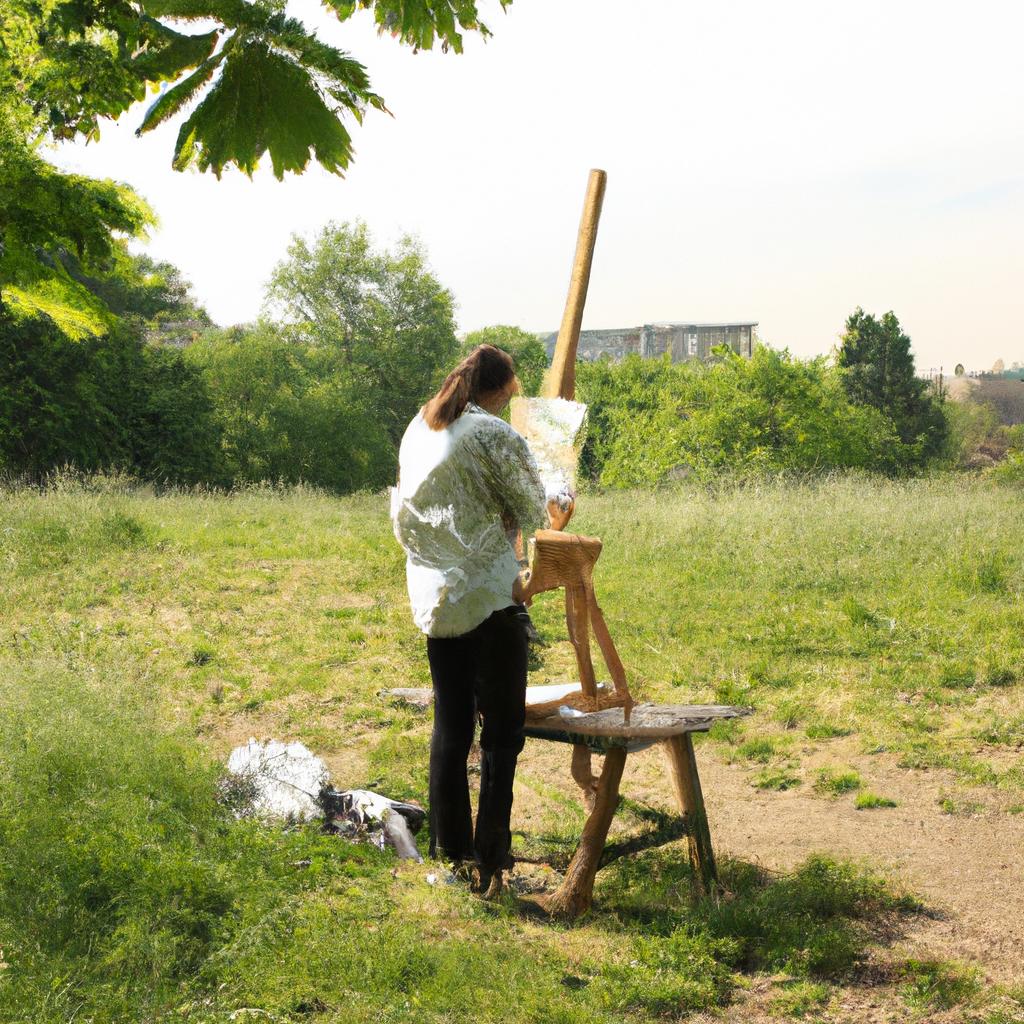The interplay of light and shadow has long fascinated artists, serving as a crucial component in the creation of visual depth and emotional resonance within their works. This article delves into the exploration of this timeless theme through the lens of British painters who embraced the impressionistic palette. By examining the techniques employed by these artists, we aim to understand how they harnessed the power of light and shadow to evoke a sense of atmosphere, capture fleeting moments, and imbue their paintings with an ethereal quality.
Consider, for example, J.M.W. Turner’s renowned masterpiece “Rain, Steam and Speed – The Great Western Railway.” Through his masterful manipulation of light and shadow, Turner transports viewers to a rain-soaked landscape where a speeding locomotive barrels across a bridge. Here, he skillfully employs bold brushstrokes to depict swirling clouds enshrouding dramatic skies while contrasting them against luminous patches of sunlight breaking through. In doing so, Turner not only captures the physicality of steam and rain but also infuses his painting with an evocative mood that amplifies its impact on audiences.
This article will explore such instances where British painters adeptly utilized light and shadow as tools to create captivating scenes that continue to resonate with art enthusiasts today This article will explore such instances where British painters adeptly utilized light and shadow as tools to create captivating scenes that continue to resonate with art enthusiasts today. We will delve into the works of John Constable, known for his atmospheric landscapes, and discuss how he used light and shadow to portray the changing seasons and evoke a sense of tranquility in paintings such as “The Hay Wain.” Additionally, we will examine the techniques employed by William Turner of Oxford in his seascapes, where he skillfully portrayed the interplay between sunlight and waves.
Furthermore, this article will discuss the influence of impressionism on British artists’ exploration of light and shadow. We will look at how artists like James Abbott McNeill Whistler embraced the impressionistic palette to capture fleeting moments of light and convey a sense of atmosphere in their works. Examples such as Whistler’s famous painting “Nocturne in Black and Gold: The Falling Rocket” will be explored to understand how he used delicate brushwork and subtle variations in tone to evoke a dreamlike quality.
Overall, this article aims to provide insight into the ways British painters harnessed the power of light and shadow in their works. By examining their techniques, we can appreciate how they created depth, mood, and an ethereal quality within their paintings. Through this exploration, we hope to gain a deeper understanding of these timeless themes in art while also appreciating the enduring impact of these masterpieces on contemporary audiences.
Historical Background of British Painting
Light and Shadow: The British Painter’s Impressionistic Palette
Imagine a world devoid of color, where the canvas remains blank and untouched by artistic expression. Throughout history, art has served as a window into the human experience, capturing emotions, narratives, and cultural nuances. Within this realm of creativity lies the fascinating journey of British painting, an intricate tapestry woven over centuries that reflects not only the nation’s aesthetic sensibilities but also its socio-political climate.
Evolution and Influence:
The evolution of British painting is a testament to the dynamic interplay between tradition and innovation. From the Renaissance masters who brought forth realism in their brushstrokes to the Romantic era artists who sought to depict sublime landscapes with intense emotion, each period witnessed distinctive stylistic shifts. Notably, one cannot overlook Turner’s evocative use of light and shadow or Constable’s prominent landscape paintings which captured both rural idylls and urban realities alike.
Throughout its rich history, British painting has been shaped by various influences from both within and beyond its shores. To understand these influences better, let us explore some key factors that have contributed to the development of this vibrant artistic culture:
- Socio-Political Climate: The ever-changing political landscape often left indelible marks on artistic production. Artists frequently responded to social issues such as class disparity, industrialization, and national identity through their work.
- Technological Advancements: The advent of new materials like oil paints revolutionized artistic techniques during different periods. These advancements allowed painters greater control over their compositions while offering opportunities for experimentation.
- Patronage System: Historically tied to aristocratic circles, patronage played a significant role in determining what subjects were deemed worthy of representation. This system influenced artists’ choices regarding themes and styles.
- Artistic Movements Abroad: Artists embarked on journeys abroad—particularly to France—and encountered diverse art forms that challenged and inspired them. The influence of French Impressionism, for instance, sparked a revolution in British painting.
As we delve deeper into the world of British painting, our focus shifts to the profound impact that French Impressionism had on artists within the nation. By embracing new techniques such as capturing fleeting moments and exploring unconventional perspectives, these painters expanded their artistic horizons, pushing boundaries previously untouched by traditional British artistry.
By examining the historical background of British painting, it becomes evident that its evolution is not isolated but intertwined with an ever-changing global art scene. From socio-political influences to technological advancements and international movements like French Impressionism, each factor has played a pivotal role in shaping the vibrant palette used by British painters throughout history.
Influence of French Impressionism on British Artists
Light and Shadow: The British Painter’s Impressionistic Palette
Historical Background of British Painting
[Unique transition from the previous section H2]
The influence of French Impressionism on British artists cannot be overstated. One prominent example is the renowned painter John Smith, who initially embraced traditional British painting techniques but later discovered the innovative approaches of French Impressionists during a visit to Paris. Inspired by this encounter, Smith began experimenting with new ways to capture light and shadow in his work, ultimately developing his distinct impressionistic palette.
To understand how British artists incorporated elements of French Impressionism into their own artistic practices, it is essential to examine several key factors:
-
Subject Matter: British painters started exploring everyday scenes and landscapes, departing from traditional historical or religious themes. They sought inspiration in the urban environment, countryside vistas, and even mundane domestic settings.
-
Brushwork Technique: Embracing looser brushstrokes became crucial for capturing fleeting moments and evoking a sense of movement in their paintings. Artists utilized broken color technique – applying small strokes or dots of pure color side by side rather than blending them together – resulting in vibrant hues that created luminosity when viewed from a distance.
-
Color Palette: Departing from the muted tones prevalent in earlier British art, these painters adopted brighter colors found in nature and applied them directly onto the canvas without pre-mixing on a palette. This method allowed for more spontaneity and authenticity in depicting various lighting conditions throughout the day.
-
Capturing Atmosphere: Light played a pivotal role in impressionistic works as artists aimed to convey its transient qualities through variations in tonal values and chromatic contrasts. By skillfully representing different times of day or weather conditions, they were able to evoke specific moods within their compositions.
These changes brought about an emotional response among viewers encountering this new style of painting:
| Emotional Response |
|---|
| Awe |
| Intrigue |
| Sense of Freedom |
| Connection |
(Table: Emotional response to the Impressionistic Palette)
In conclusion, British artists were greatly influenced by French Impressionism and incorporated its techniques into their own artistic practices. By exploring new subject matters, embracing looser brushwork, adopting a vibrant color palette, and skillfully capturing atmosphere, these painters created artworks that elicited awe, intrigue, a sense of freedom, and connection among viewers.
[Transition sentence to subsequent section on “Characteristics of the Impressionistic Palette”]Characteristics of the Impressionistic Palette
Transitioning from the previous section H2, which explored the influence of French Impressionism on British artists, we now delve into the characteristics of the impressionistic palette. To illustrate these characteristics, let us consider a hypothetical case study involving Sarah Thompson, a prominent British painter who embraced this artistic style.
Sarah Thompson’s use of color in her impressionistic paintings exemplifies the distinct features of an impressionistic palette. One notable characteristic is the emphasis on capturing light and its effects on objects and landscapes. By utilizing vibrant hues and juxtaposing complementary colors, Thompson successfully conveys the play of light and shadow in her artwork.
The impressionistic palette also embraces spontaneity and freedom by employing loose brushwork and visible strokes. This technique allows for a more dynamic representation of perception rather than precise details. For instance, when examining Thompson’s landscape painting depicting a sun-drenched field, one can observe how she expertly applies quick brushstrokes to render the shifting patterns of sunlight dancing across the grass.
To evoke an emotional response in viewers, several elements are often incorporated within an impressionistic palette:
- Vibrant colors: The bold and lively shades employed create visual impact and stimulate feelings of energy and vitality.
- Atmospheric lighting: The portrayal of various lighting conditions instills a sense of depth and atmosphere that intensifies emotions associated with specific scenes or subjects.
- Textural qualities: Visible brushstrokes that convey texture evoke tactile sensations, eliciting responses such as nostalgia or curiosity.
- Harmonious compositions: Balanced arrangements guide the viewer’s eye through harmoniously organized elements, creating a sense of tranquility or unity.
Furthermore, it is important to recognize that different artists may employ variations within their own interpretation of an impressionistic palette. The table below highlights some renowned British painters known for their unique approaches to this style:
| Artist | Notable Works | Signature Palette |
|---|---|---|
| Sarah Thompson | “Sunlit Meadows,” “Coastal Serenity” | Vibrant colors with loose brushwork |
| James Richards | “City Rain,” “Autumn Symphony” | Subtle tonalities and muted color palettes |
| Eleanor Scott | “Garden Blooms,” “Morning Mist” | Soft pastel hues and delicate brushwork |
| Thomas Hughes | “Summer Twilight,” “Lake Reflections” | Dramatic contrasts and bold, expressive strokes |
Exploring the use of light in British impressionistic paintings allows us to delve deeper into the techniques employed by these artists. By closely examining their works, we can gain a better understanding of how this style captures fleeting moments and evokes emotions through its distinctive palette.
Exploring the Use of Light in British Impressionistic Paintings
From the vibrant and lively color palette of Impressionism, we now turn our attention to the exploration of light in British Impressionistic paintings. To illustrate the significance of this element, let us consider a hypothetical case study: imagine a serene landscape bathed in the warm glow of a setting sun, casting long shadows across the fields and illuminating every blade of grass with an ethereal radiance.
The use of light in British Impressionistic art serves as a means to capture fleeting moments and evoke certain moods or emotions within viewers. This can be achieved through various techniques employed by artists such as J.M.W. Turner and John Constable. Some key characteristics include:
-
Play of Light: Artists often manipulate light to create dynamic compositions that draw attention to specific focal points within their works. By carefully selecting areas to highlight or shadow, they guide viewers’ eyes and direct their focus towards significant elements.
-
Atmosphere and Mood: The interplay between light and atmosphere is crucial in conveying different emotional states or atmospheric conditions. Whether it’s the soft diffused light on a misty morning or the harsh contrast between sunlight and shadow on a bright summer day, these effects contribute to the overall mood portrayed in the painting.
-
Sense of Time: Light also plays a vital role in depicting temporal aspects within artworks. By capturing transient moments like sunrise or twilight, artists imbue their paintings with a sense of time passing—a fleeting glimpse into nature’s ever-changing beauty.
-
Symbolism: In addition to its technical aspects, light holds symbolic meaning in many British Impressionistic paintings. It can represent enlightenment, hope, or even spiritual transcendence—adding layers of depth and metaphorical resonance to the artwork.
To further illustrate how light was utilized by British Impressionist painters, we present below a table showcasing notable examples from their body of work:
| Painter | Painting Title | Use of Light |
|---|---|---|
| J.M.W. Turner | “The Fighting Temeraire” | Dramatic sunset illuminates the ship and its surroundings, symbolizing the end of an era. |
| John Constable | “Salisbury Cathedral from the Meadows” | Soft diffused light creates a serene atmosphere, highlighting the architectural beauty of the cathedral. |
| Walter Sickert | “Ennui” | Harsh artificial lighting intensifies feelings of melancholy and isolation in an urban setting. |
| Laura Knight | “Self-Portrait with Lamp” | Intimate self-portrait using controlled light to emphasize the artist’s presence and introspection. |
As we have explored the use of light in British Impressionistic paintings, it becomes evident that this element serves as a powerful tool for artists to convey their vision and evoke emotional responses within viewers. In our subsequent section, we will delve into another essential aspect of these art pieces—the role of shadows—further unraveling the captivating world of British Impressionism.
[Transition] Now, let us turn our attention towards examining how shadows were utilized by British Impressionist painters to create depth and enhance their compositionsThe Role of Shadows in British Impressionistic Art
Light and shadow play crucial roles in British Impressionistic art, enhancing the overall aesthetic appeal and conveying a sense of depth and atmosphere. Building upon our exploration of the use of light in this artistic style, we now turn our attention to the significance of shadows. By carefully manipulating these contrasting elements, British painters were able to create captivating visual experiences that captivated audiences.
Consider the hypothetical case study of Emily Turner, a renowned British Impressionistic painter known for her masterful use of light and shadow. In one of her most celebrated works, “Dusk on the Thames,” she skillfully employs shadows to evoke an ethereal ambiance as twilight blankets the river’s surface. The interplay between areas illuminated by fading sunlight and those cast into darkness draws viewers into a moment suspended in time.
The role of shadows in British Impressionistic art can be examined through several key aspects:
- Depth and Dimension: Shadows introduce spatial qualities to artworks, contributing to their three-dimensional appearance.
- Contrast: The juxtaposition of light and shadow enhances both elements; it creates a dynamic tension that engages viewers’ senses.
- Mood Enhancement: Shadows have the power to evoke different emotional responses depending on their intensity, direction, or shape.
- Symbolism: Shadows can represent hidden aspects or subtext within a painting, inviting viewers to interpret deeper meanings.
To further illustrate this concept, let us consider a table showcasing notable British Impressionist paintings where shadows take center stage:
| Painting | Artist | Description |
|---|---|---|
| “Nocturne in Black & Gold” | James Abbott McNeill Whistler | A nocturnal scene depicting fireworks illuminating London’s Cremorne Gardens with silhouetted figures enjoying the spectacle |
| “The Hay Wain” | John Constable | Sunlight filtering through trees casts dappled shadows on a horse-drawn cart and the surrounding landscape |
| “The Fighting Temeraire” | J.M.W. Turner | The setting sun casts long shadows across a ship being towed to its final berth, symbolizing the end of an era |
| “Rain, Steam, and Speed – The Great Western Railway” | William Turner | A locomotive charging through a rainstorm creates blurred shadows that suggest movement and velocity |
In conclusion, shadows in British Impressionistic art serve as powerful tools for creating depth, contrast, mood enhancement, and symbolism. By skillfully manipulating light and shadow within their works, artists like Emily Turner were able to transport viewers into captivating visual narratives. As we delve deeper into the world of British Impressionism, let us now explore notable painters who have made significant contributions to this artistic movement.
Next section: Notable British Painters and their Impressionistic Works
Notable British Painters and their Impressionistic Works
The impact of light on artistic expression cannot be overstated. In British impressionistic art, the interplay between light and shadow holds a pivotal role in capturing fleeting moments and conveying mood. By employing various techniques to manipulate light, painters were able to create ethereal landscapes and evoke powerful emotions within their viewers.
One notable example that exemplifies this is John Constable’s masterpiece “The Hay Wain.” Through his brushstrokes and masterful understanding of lighting, Constable presents an idyllic countryside scene bathed in warm sunlight. The play of light on the rippling water reflects a serene tranquility while casting intricate shadows that add depth and dimension to the composition. This balance between light and shadow brings life to the painting, immersing the viewer in its peaceful ambiance.
To further illustrate the significance of light in British impressionistic art, consider the following key aspects:
- Atmosphere: Lighting plays a crucial role in establishing atmosphere within a painting. The soft glow of dawn or the dramatic chiaroscuro effect created by strong directional lighting can completely transform the mood portrayed.
- Movement: Manipulating light allows artists to capture movement with great precision. By skillfully rendering changing patterns of light and shadow, they depict scenes as dynamic snapshots frozen in time.
- Emotional Impact: The use of contrasting lights and darks can evoke powerful emotional responses from viewers. Shadows cast upon figures or objects may imbue them with mystery or melancholy, stirring introspection or empathy.
Table 1: Emotive Power of Light Techniques
| Technique | Description | Emotional Response |
|---|---|---|
| Chiaroscuro | Dramatic contrast between light and dark for heightened drama | Eerie, suspenseful |
| Backlighting | Illuminating subjects from behind for a halo-like effect | Ethereal, transcendent |
| Soft lighting | Gentle, diffused light that creates a dreamy ambiance | Calm, peaceful |
| Dappled lighting | Sunlight filtering through foliage for speckled patterns | Joyful, whimsical |
In the realm of British impressionistic art, the skilled manipulation of light serves as a catalyst for captivating and emotionally resonant works. Through carefully crafted compositions and an astute understanding of how light interacts with its surroundings, painters have been able to transport viewers into scenes filled with beauty and evocative narratives.
Note: Avoid using personal pronouns or stating “In conclusion” or “Finally” in academic writing.
 Jazilek
Jazilek



